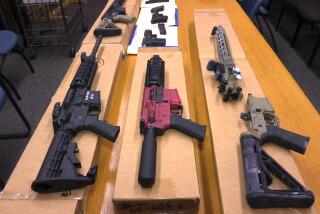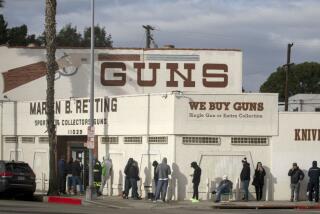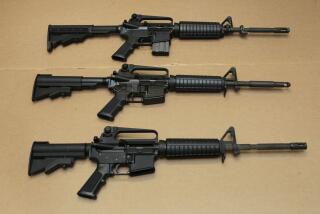Smith & Wesson joins fight against ‘microstamping’
- Share via
SACRAMENTO — Gun maker Smith & Wesson announced Thursday that it would stop selling newly designed semiautomatic pistols in California because of a state law requiring those firearms to imprint a unique, identifying “microstamp” on bullet casings.
The law, signed by Gov. Arnold Schwarzenegger in 2007 but not implemented until May 2013, is intended to help police investigators link shell casings found at crime scenes to a specific gun.
Smith & Wesson joins gun maker Sturm, Ruger & Co. in halting the sales. Both companies criticized the microstamping requirement as costly, unreliable and ineffective, saying that there is no evidence that it will help solve crimes.
Smith & Wesson President and Chief Executive James Debney, in a statement released Thursday, said the law was poorly conceived and would make it impossible for Californians to have “access to the best products with the latest innovations.”
Los Angeles City Atty. Mike Feuer, who introduced the legislation while serving in the state Assembly, called the gun lobby’s objections “baloney.” He said the new technology gives police critical evidence in handgun-related killings, hundreds of which go unsolved every year, and the legislation had wide support from law enforcement agencies.
“This law is about solving gun crimes, and it’s a law that would be effective in doing that if only the gun lobby would step aside,” Feuer said.
Feuer said microstamping technology has been reliable and available since before the 2007 law was passed and costs only a few dollars per gun to install — although gun makers dispute this.
“Their posturing doesn’t surprise me,” Feuer said of the manufacturers. “We all know that the gun lobby has no problem innovating when it comes to making guns more lethal.”
The microstamping requirement is limited to newly designed semiautomatic handguns and older models that have been updated or modified by gun makers. Those semiautomatic pistols are required to have a microscopic etching identifying the make, model and serial number in two places on the weapon, presumably the firing pin and barrel, allowing the information to be stamped on a bullet casing when the pistol is fired.
Chuck Michel, a Long Beach attorney who represents the National Rifle Assn. in California, said the law punishes gun makers who offer safer new handguns or who make safety improvements to older models. The restriction also could affect law enforcement agencies seeking to order newly designed firearms that are now banned, he said.
“Hopefully, we can convince some of the regulators to take a look at their policy,” Michel said. “Barring that, there’s going to be legislation proposed to put these guns back on the roster.”
Two organizations representing gun makers, the National Shooting Sports Foundation and the Sporting Arms and Ammunition Manufacturers Institute, filed a lawsuit in January in Fresno County seeking to invalidate the law. The suit argues that studies have revealed too many questions about the technology and cost to require its use on new guns.
Implementation of the law was delayed until last year, when the state attorney general’s office could certify that the microstamping technology was not restricted by patent protections.
More to Read
Sign up for Essential California
The most important California stories and recommendations in your inbox every morning.
You may occasionally receive promotional content from the Los Angeles Times.











